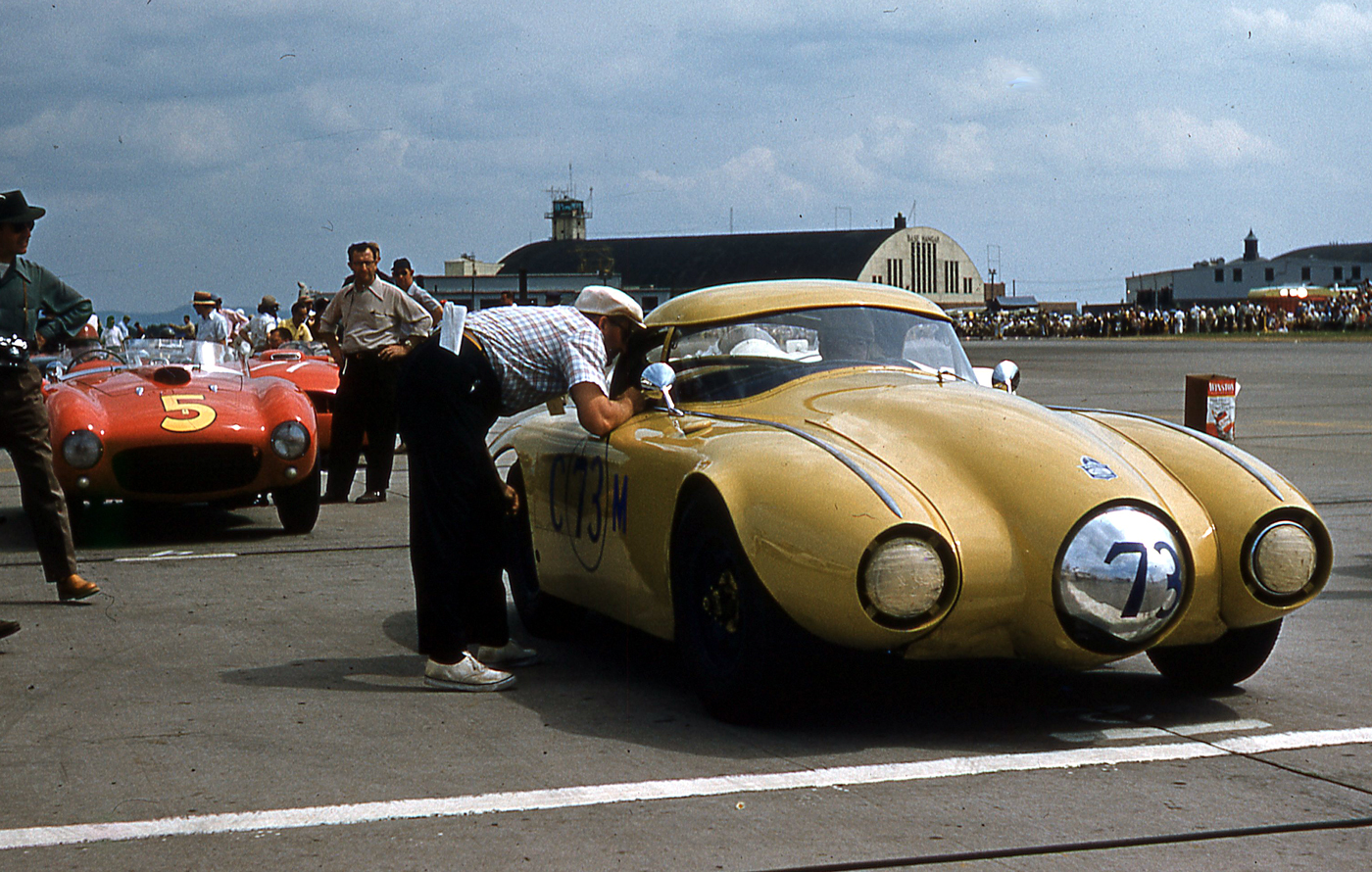
Porsche Fageol on the grid for the C-Modified SCCA event a Westover, Massachusetts AFB, June 13, 1954. Photo by Robert Pauley.
Story by Pete Vack
Born into a family of entrepreneurs and engineers, Louis J. Fageol (pronounced fadjl) would take over the family’s Twin Coach bus and tractor business as planned, but at the same time was hell bent for leather to satisfy his need for speed despite the wishes of his wife Caryl. Already famed for his speedboat victories, Fageol would push the envelope of all-wheel-drive race cars with his ultimate creation, the Fageol Porsche sports racer. In doing so, his life would literally hang by a thread.
Despite the business of manufacturing large buses and tractors, the Fageol family had been fascinated with automobiles since Lou’s father William and Uncle Frank began constructing sightseeing buses in Oakland, California, in 1915. By 1916 the brothers were also manufacturing high end automobiles, powered by a 13.3 liter Hall Scott aviation engine, featuring six cylinders and a SOHC valve operation. Though the automobile business failed, Lou Fageol obviously came by his addiction honestly.
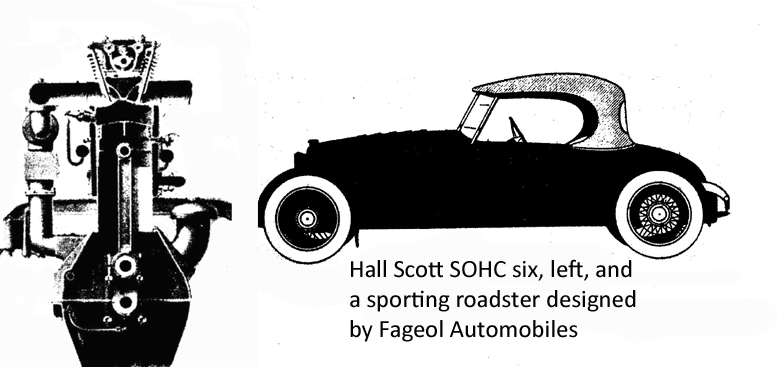
We apologize for the poor reproduction of this ancient diagram (from Road & Track, December 1955) of the Hall and Scott SOHC engine from 1916, used to power the new Fageol automobiles.
In 1927 the brothers headed east to Kent, Ohio to begin a new company, Twin Coach, which would manufacture a range of unique twin engine buses patented by William Fageol. Son Lou would be groomed to take over the reins of the company, but it wasn’t until 1946 that the younger Fageol took control.
Outwardly, the huge Fageol Twin Coach buses were the exact opposite of the small, fast and fleet sports cars Lou Fageol built and raced as a hobby. But inside, both the famous twin-engine Indy car and Porsche sports car, like the buses, featured two engines,
one in each end.
Fageol was fascinated with speed and competition at an early age. He was only 21 when he decided to take part in a new sport, motorboat racing. “‘My first outboard was an Evinrude racing job,” he recalled. “I bought it on time. In California I was one of the early ‘hop-up’ fans, stepping up automobile and outboard engines.” In 1927 Lou helped design and build an outboard motorboat for events on California’s lakes. During his first race, the “Caryl I” (named for his new wife) was boxed off course, hitting a half sunk log and flipped. Though uninjured, he remarked, “Well, that’s the first lesson.” But he won the next race he entered.
That boat race was an outboard free-for-all at San Joaquin Calif., May 26, 1928. And let there be no doubt that Lou Fageol was a very successful unlimited power boat racer, achieving many records and successes throughout his career. His Gold Cup Class ‘So-Long’ amassed number of trophies from 1939-1941 and in 1942 his ‘So-Long Jr.’ won in the 225 cubic inch class.
Though he started in powerboats, by the late thirties he decided to race at Indianapolis. Lou’s son Ray recalled that “Dad got wind of Ford wanting to scrap its Miller-Fords, so he bought six of them.” Motor boat racing was dangerous, and motor car racing perhaps even more so, and eventually, his wife and the boat’s namesake Caryl banned him from driving race cars. Since he couldn’t drive, Fageol simply hired other drivers to pilot his new cars at Indianapolis, including Mel Hansen, who drove one of the six Miller-Fords in the 1941 race but retired just a dozen or so laps in.
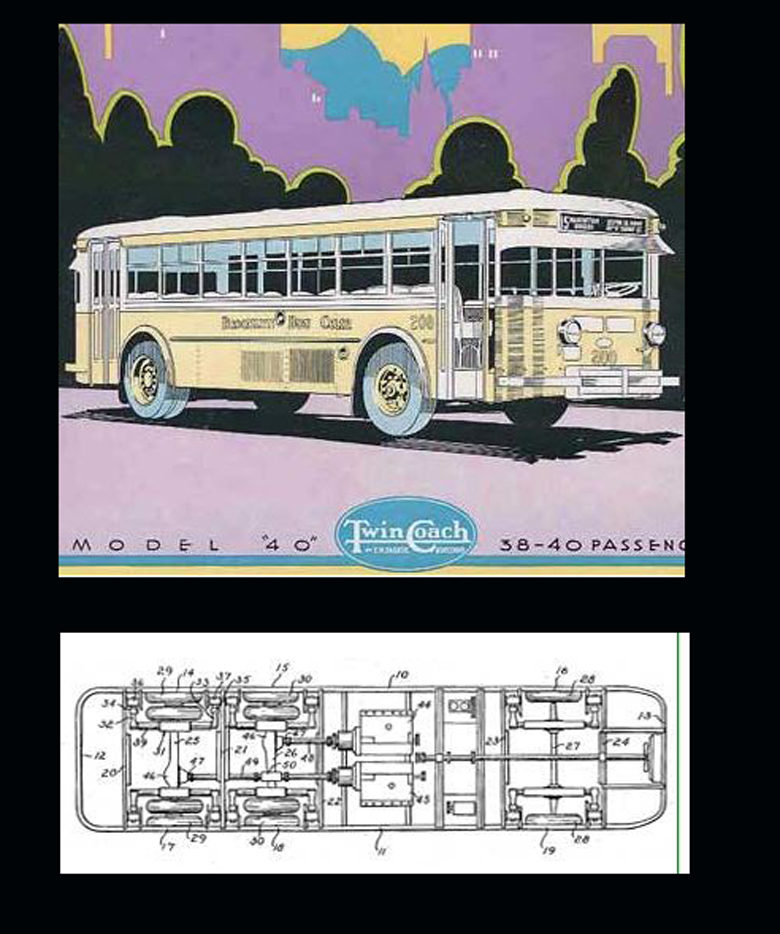
Brochures and ads for the Fageol buses. Note the twin engine layout, similar to the Bugatti railcars.
The war put an end to Caryl’s worries, as there would be no racing of any kind until 1946. By then, Lou had inherited the leadership of the Twin Coach Bus Company which had done very well during the war from military contracts. Business was booming and though he had more responsibilities than ever, Fageol now had the budget (via advertising) to go racing in a big way. Fageol also resumed powerboat racing in the new 7-litre Class with the ‘So-Long Jr.’, taking the Silver Cup at the 1946 APBA races in Detroit. In June of 1950 Fageol bested Sir Malcolm Campbell’s 141.740 m.p.h. world water speed record driving Stanley S. Sayres’ Slo-Mo-Shun IV, attaining 160.86 m.p.h.
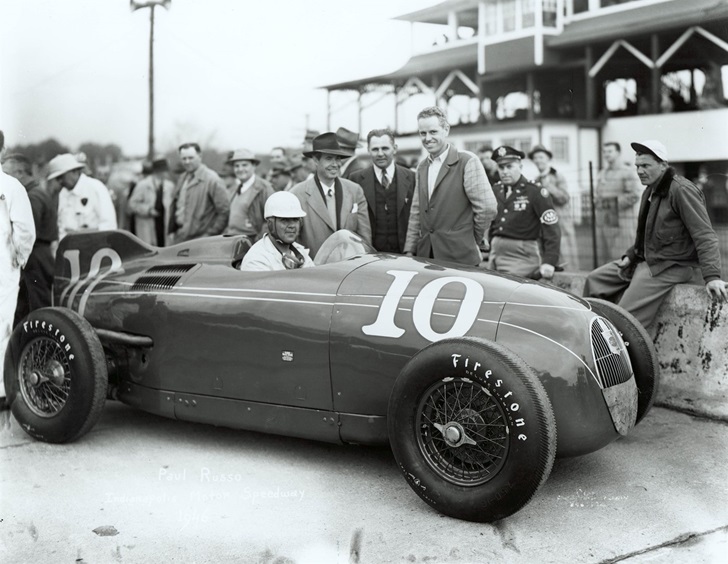
Paul Russo with the Fageol twin Offy at Indy in 1946. It was fast and front and center in the front row. Credit IMS photos and use with permission.
On dry land, a new car was developed for the 1946 Indianapolis 500, with twin Miller engines that would reflect the twin-engine Twin Coach buses. This could have been a waste of time, but it was well engineered and constructed. Lou’s theory, it was said, was that “a car with a 50/50 weight distribution would go into a four-wheel power drift instead of spinning out after reaching the limits of tire adhesion.”
What they didn’t anticipate was sliding out on a patch oil left by another racer. VeloceToday reader and contributor Eric Davison was there. “I was fortunate to have attended the 1946 running of the Indy 500. While I was too young to appreciate either the significance of the event or the entry list that included Maserati, Alfa Romeo and Mercedes. It also included the Fageol ‘Twin Coach Special’ a twin-engine car using two 1500cc Miller engines, one at each end. It was a beautiful car and qualified on the front row driven by Paul Russo. It ran well, among the leaders but crashed out on the 16th lap.”
Caryl no doubt was relieved. While Fageol decided that he’d let others drive the Indy cars for him, he was soon at work creating another twin engine device that he figured was safe enough for him to drive competitively. And perhaps Caryl had a change of heart. In a 1953 interview, Caryl was described as “…one of those wonderful women who share the same interests as their husbands.” When asked about Lou’s need for speed, she said, “All of us in the family are enthusiastic about sports cars…they are probably the most practical hobby any man could have.”
Sure enough, Lou’s son Ray inherited the sports car bug. After the accident at Indy, the famous Fageol Twin Coach Indianapolis special sat idle until Ray built a sports car from the remains, now powered by a 225 h.p. Twin-Coach 6-cylinder engine, called the ‘PataRay’ the sports car appeared on the cover of the May 1953 cover of Mechanix Illustrated as the ‘Fageol Special’.
Lou’s garage in Kent, Ohio, circa 1953, harbored a very special gold XK120 Jaguar, his Fageol roadster based on the Indy car, a 1951 Renault, a Lincoln Capri and two Cadillacs. But the special he would be famous for had not yet been built, or at least shown to the public. That’s the one in which Lou would again don his helmet, and it was indeed, very special.
Not in his garage was a Porsche, probably because by 1952, now smitten with the new German sports car, Fageol bought a nearby Porsche dealership. He immediately obtained a new 356 coupe, and installed a second Porsche engine up front, successfully campaigning it in several SCCA events in the Midwest. This led to the creation of a totally new chassis, complete with a new body constructed from two Fletcher Aviation drop tanks. It looked as advanced as it was, for All Wheel Drive cars were rare and racing AWDs were even rarer. It was also complex. In addition to the duplication of controls (a problem which confronted all such twin-engine efforts), Fageol decided to supercharge the engines, and run the superchargers via two Fageol chain saw engines. That made it a four-engine race car!
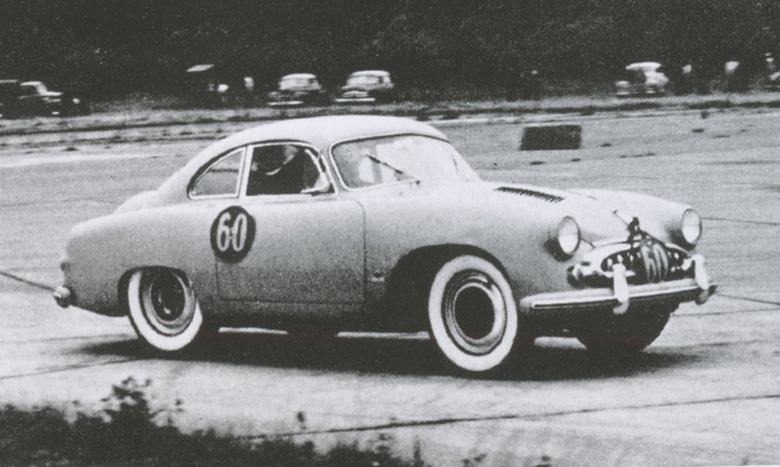
The first Fageol Porsche with an extra engine upfront. The grille was really functional! Here seen at Everett Washington, Paine Field, on August 8, 1953. According to reports, the car ran fast but retired after 12 laps with clutch problems. The next day Lou drove the Slo-Mo V hydroplane to second place in the Gold Cup races on Lake Washington. Photographer unknown.
Four engines and two superchargers made their presence known. Jim Sitz watched the Fageol Porsche race at Pebble Beach. “The twin superchargers shrieked, the twin Porsche engines howled, and what a magnificent racket it made!”
And in fact, Lou was driving well and the twin powered Porsche was a contender in SCCA races. Until that is, until his accident at Pebble Beach in April of 1955. There are various accounts; Sports Car Specials has Lou getting into a patch of oil as he entered the apex of a corner, resulting in an end over end accident. Another account was more specific, and given the nature of luck and odds, probably closer to the truth. “… One of the two transmissions fell into a different gear, sending the car into a violent end-over-end tumble, landing on its roof. Rescuers discovered him hanging upside down in the overturned car, calmly smoking a cigarette.” And other reports indicate that while he was having a smoke, another car hit the twin Porsche, causing the car to be totaled and produced cuts on Lou’s face.
What Caryl thought of all this is left unrecorded. His race car was a mess, but he still had his speedboats and what is recorded is that accidents plagued Fageol over the summer and in September of 1955 at a Gold Cup boat race in Seattle, his Slo-Mo-Shun speedboat went airborne and Fageol fell out of the cockpit, suffering a collapsed lung as he landed in the water. A few weeks later, Lou Fageol finally called it quits.
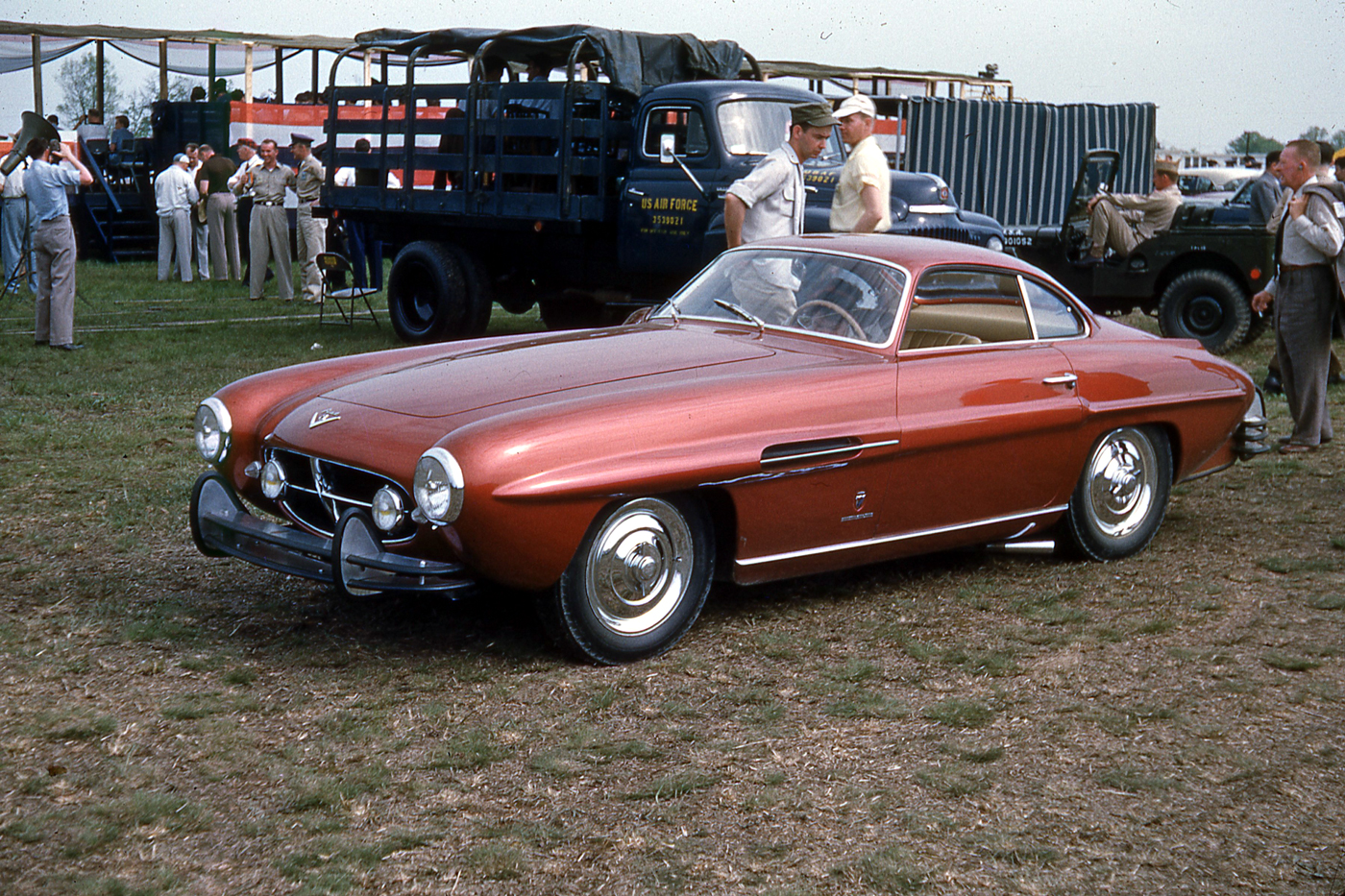
Readers ask, we provide. We forgot to include this photo of Lou Fageol’s Fiat 8 V Ghia Supersonic, here at Andrews AFB on May 2, 1954. Photo by Robert Pauley.
Or did he? Jim Sitz recalls that late in his career, Lou Fageol could still be seen racing a Crosley Special out of his new hometown of San Diego. In Jim’s extensive notes, he finds that on October 31, 1958 Fageol bought the ex-Harry Jones Crosley special “ready for racing next year.” And sure enough, true to form, Lou Fageol entered the races at Pomona, California on March 3, 1960. The car had an accident in the opener and did not start in the feature.
Less than a year later, Lou Fageol’s time had run out. On January 18, 1961, the Associated Press wire service announcing his death as follows:
“SAN DIEGO, Calif. (AP)-Louis J. Fageol, 54, noted hydroplane race driver and retired bus manufacturer, died Monday of a heart condition, and other ailments. He retired in 1958 as chairman of the Twin Coach Bus Co. of Kent, Ohio. He was born in Oakland, California.”
Sources
Email interview with Eric Davison, January 30, 2020
Email interview with Jim Sitz, February 2020
Auto Sportsman, June 1953, page 50
Sportscar Specials, Trend Book 178, 1958 Rolofson, page 84
Road & Track, December 1955 page 38
https://www.hemmings.com/blog/2019/05/31/split-apart-stolen-and-misidentified-fageols-supersonic-pataray-led-a-tortured-existence/
http://www.coachbuilt.com/bui/t/twin_coach/twin_coach.htm
http://www.coachbuilt.com/bui/f/fageol/fageol.htm

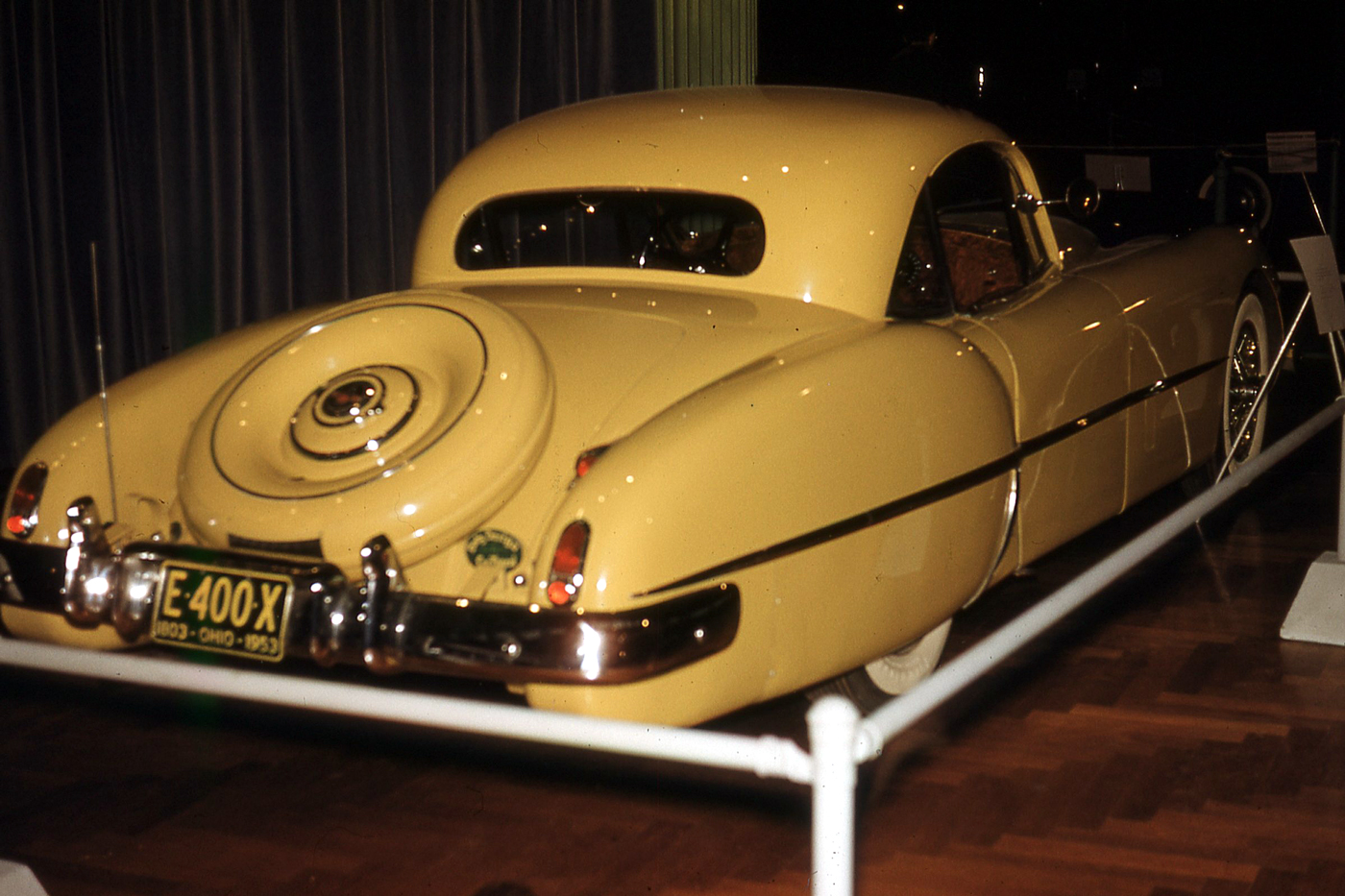
Great story. I remember the hoopla when Fageol entered his twin-engined Porsche in the Giant’s Despair Hill Climb in Wilkes-Barre, Pa. some time in the mid ‘50s. Don’t remember how it performed, but was a contender for honors.
I corresponded with Charlie Strang until he passed at 96. He was the chief engineer of Kiekhaefer Mercury outboards and left there in 1964. He was hired by Ralph Evinrude to do the same job. Strang was very active in with the boat sanctioning groups for two generations and in his 80s was the Commissioner of NASCAR. I wrote him initially with questions about my vintage Mercury outboard collection, and that led to car stuff and sharing my uncle’s early VMCCA and SCCA photos from the late 1940s and postwar road racing in America . His name was Paul Timmins; e was the second owner of the Hansgen Special Jaguar which is now in England. Anyway , I sent Strang my uncle’s photo of the twin engine Porsche which he said he never saw completed. Strang said he was approached by Feagol abuot modifying two Kiekhaefer Mercury chainsaw engines for blower work. Strang said he had thought about mounting a 4 cylinder Mark 30 outboard powerhead above a car engine to drive a supercharger anyway. So he put his Mercury engineers to work tuning the chainsaw engines to drive a blower of some kind for Feagol. So they ended up in the twin engine car – one chainsaw engine directing air to the front or back. Strang never saw the car like I said , but he heard from Feagol the car was squirrelly or words to that effect !
I can provide Strangs email if you want it for the historical record. Let me know.
I posted a YouTube with my uncle Paul Timmins (with one eye), Walt Hansgen, Briggs Cunningham etc . Look for SCCA NAtional Races, Sept 5, 1954
No mention of the “Fageol Supersonic”? OK, it wasn’t twin-engined, but it was an important part of his life with speed cars.
Any idea where the twin engined “bent windshield” 356 Porsche coupe ended up?
I’ve collected Packard cars since I was 14, and the moment I saw the front grill on that 356, I knew it was the inner grill assembly for 1951 – 52 Packards. I know from working on these cars that the inner grill is heavy diecast metal, and the “teeth” are bumper-strength steel, with the entire unit estimated at around 60 to 80 pounds. I wonder if the extra weight was there to help with the 50/50 weight distribution, or Lou Fageol simply liked the look?
Tony,
Thanks for reminding us! We had a great photo by Robert Pauley we forgot to include in the story. It is now in place.
Pete
On page 147 of Pebble Beach Remembered by Art Evans there is a reference to the Fageol car entered in the 1955 race. It is part of a report on the race written by Scott Warren for Sports Car, the official publication of the SCCA. It reads as follows: “Of great interest was Lou Fageol’s twin Porsche. This Rube Goldbergian machine (for those few unfamiliar with its construction) was a Porsche coupe powered by two supercharged Porsche engines. An engine for the front wheels and another for the rear. To further complicate an already fantastic situation, each engine was attended (one scarely (sic) knows how else to put it) by an outboard motor to drive the supercharger. The result of all this mechanical activity was a four-wheel drive Class C machine with really fantastic acceleration, rather questionable road-holding, and a sound like a squadron of P-38s strafing.”
The car was actually listed in the program as being in Class B.
he and croffton [the croffton of the croffton bug [jeep] took two croslys and made a flat 8 back to back